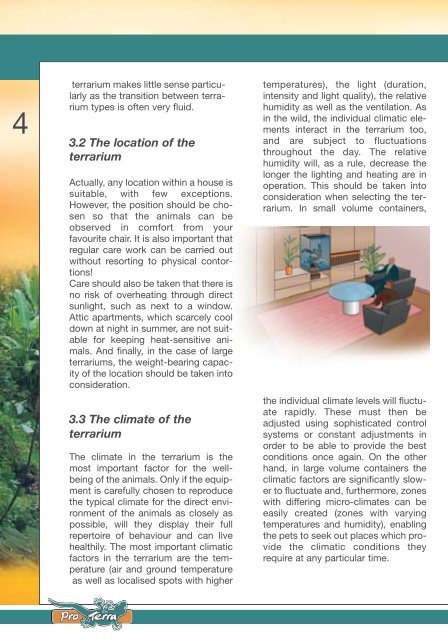How? Setting up a terrarium Useful tips for ... - Reptiles Greece
How? Setting up a terrarium Useful tips for ... - Reptiles Greece
How? Setting up a terrarium Useful tips for ... - Reptiles Greece
You also want an ePaper? Increase the reach of your titles
YUMPU automatically turns print PDFs into web optimized ePapers that Google loves.
<strong>terrarium</strong> makes little sense particularly<br />
as the transition between <strong>terrarium</strong><br />
types is often very fluid.<br />
3.2 The location of the<br />
<strong>terrarium</strong><br />
Actually, any location within a house is<br />
suitable, with few exceptions.<br />
<strong>How</strong>ever, the position should be chosen<br />
so that the animals can be<br />
observed in com<strong>for</strong>t from your<br />
favourite chair. It is also important that<br />
regular care work can be carried out<br />
without resorting to physical contortions!<br />
Care should also be taken that there is<br />
no risk of overheating through direct<br />
sunlight, such as next to a window.<br />
Attic apartments, which scarcely cool<br />
down at night in summer, are not suitable<br />
<strong>for</strong> keeping heat-sensitive animals.<br />
And finally, in the case of large<br />
<strong>terrarium</strong>s, the weight-bearing capacity<br />
of the location should be taken into<br />
consideration.<br />
3.3 The climate of the<br />
<strong>terrarium</strong><br />
The climate in the <strong>terrarium</strong> is the<br />
most important factor <strong>for</strong> the wellbeing<br />
of the animals. Only if the equipment<br />
is carefully chosen to reproduce<br />
the typical climate <strong>for</strong> the direct environment<br />
of the animals as closely as<br />
possible, will they display their full<br />
repertoire of behaviour and can live<br />
healthily. The most important climatic<br />
factors in the <strong>terrarium</strong> are the temperature<br />
(air and ground temperature<br />
as well as localised spots with higher<br />
temperatures), the light (duration,<br />
intensity and light quality), the relative<br />
humidity as well as the ventilation. As<br />
in the wild, the individual climatic elements<br />
interact in the <strong>terrarium</strong> too,<br />
and are subject to fluctuations<br />
throughout the day. The relative<br />
humidity will, as a rule, decrease the<br />
longer the lighting and heating are in<br />
operation. This should be taken into<br />
consideration when selecting the <strong>terrarium</strong>.<br />
In small volume containers,<br />
the individual climate levels will fluctuate<br />
rapidly. These must then be<br />
adjusted using sophisticated control<br />
systems or constant adjustments in<br />
order to be able to provide the best<br />
conditions once again. On the other<br />
hand, in large volume containers the<br />
climatic factors are significantly slower<br />
to fluctuate and, furthermore, zones<br />
with differing micro-climates can be<br />
easily created (zones with varying<br />
temperatures and humidity), enabling<br />
the pets to seek out places which provide<br />
the climatic conditions they<br />
require at any particular time.



